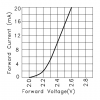LEDs require a certain amount of voltage across them before current starts to flow. Have a look at a typical V
F vs. I
F graph from a data sheet:

This graph shows how the voltage across the LED is related to the current that will flow through the LED. The LED brightness is roughly proportional to the current.
If your circuit can't provide enough voltage to cause the current through the LED to be what you want, then the current will be lower than what you want, and the LED will be dimmer than you want.
In your case, you have a 4.5V battery, and a transistor that will drop, say, 0.1V when conducting. That leaves about 4.4V across two LEDs in series. Voltages in series add together, so you will have about 2.2V across each LED. According to that graph, the LED current can't be more than about 2 mA.
These numbers, and the graph, are not exactly the same as your circuit, but they illustrate the point. And the point is that you need a higher battery voltage.
For more information, see Steve's tutorial at
https://www.electronicspoint.com/resources/got-a-question-about-driving-leds.5/


